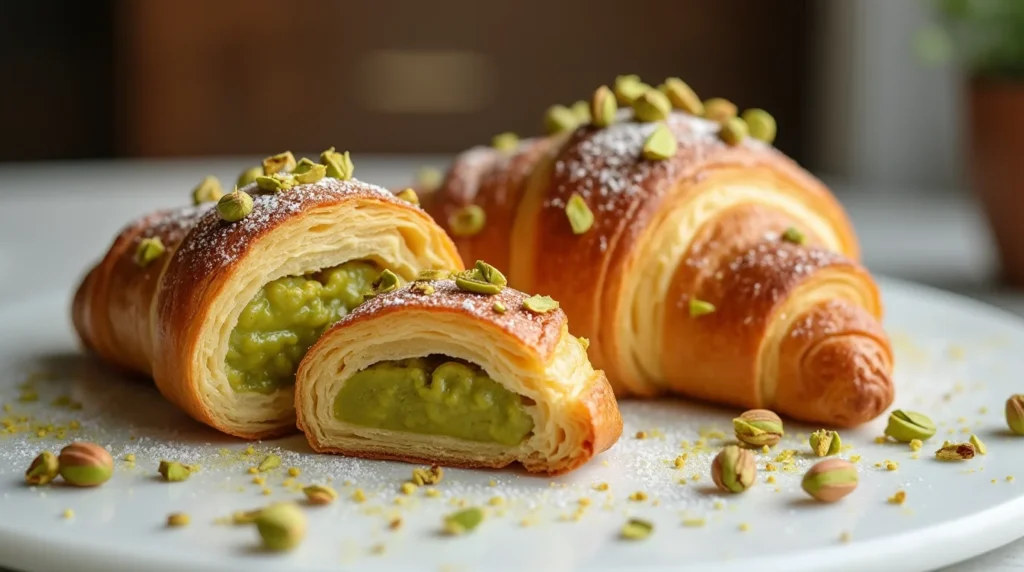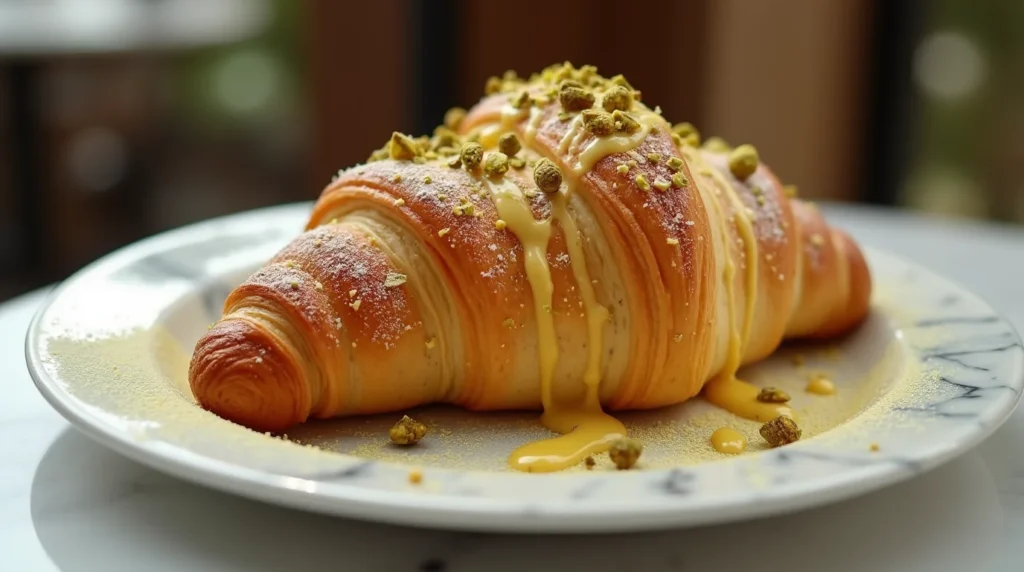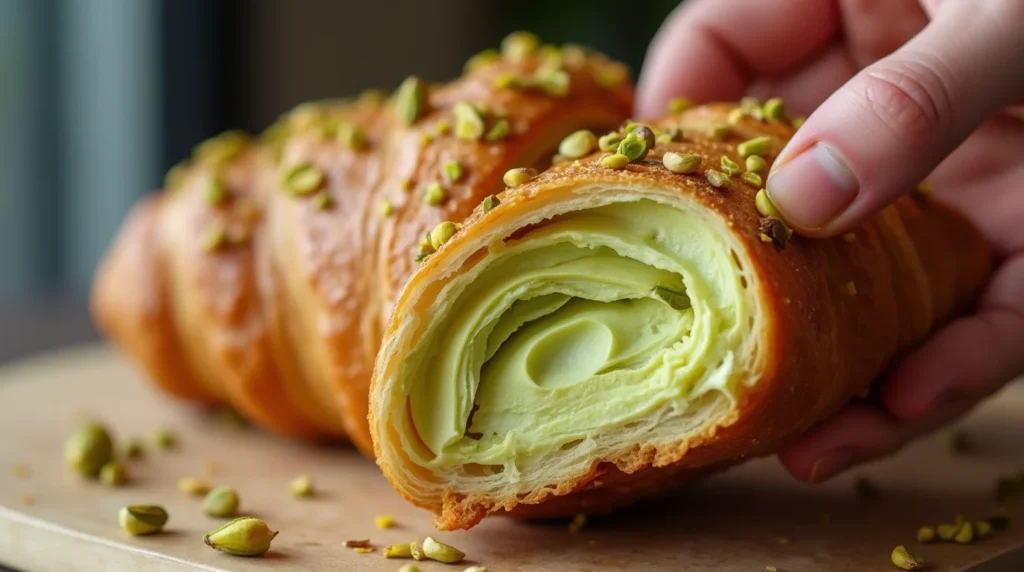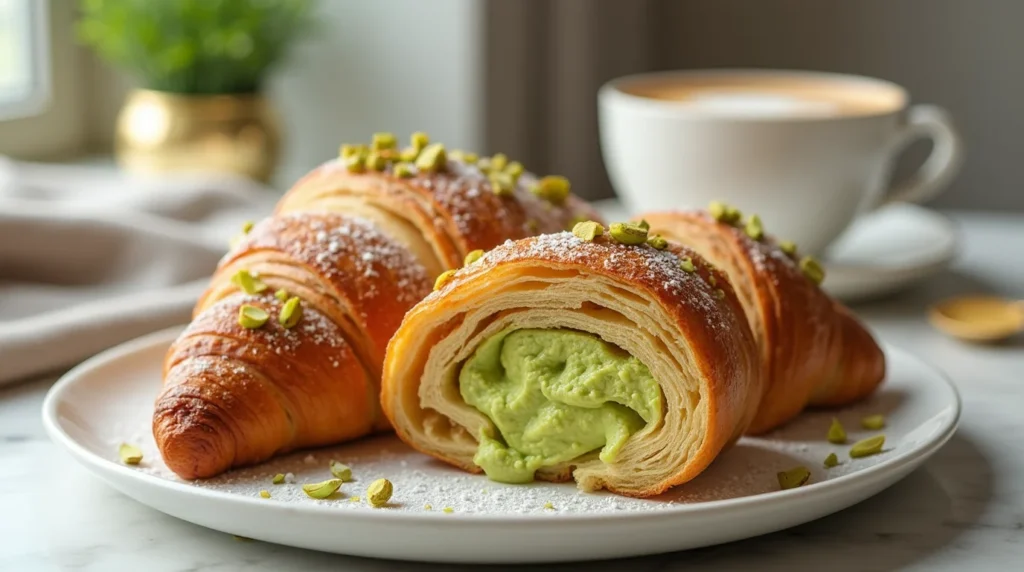
How to Make the Perfect Pistachio Croissant At home
Share this recipe
The magic of French pastries is in every flaky, buttery layer of a pistachio croissant. Imagine biting into a golden, crisp viennoiserie. It crackles with each delicate bite, revealing a rich, emerald-green pistachio filling.
Baking these exquisite French pastries is more than a task—it’s an art form. It connects you to generations of passionate bakers. They have perfected their craft over centuries.
Recipe Details
Serving Size: 8 croissants | Prep Time: 2 hours | Cook Time: 25 minutes | Total Time: 2 hours 45 minutes
Ingredients per serving
- All-purpose flour
- Unsalted butter
- Active dry yeast
- Granulated sugar
- Salt
- Whole milk
- Egg wash- Pistachio paste
Nutritional Facts (per croissant)
- Calories: 320
- Protein: 7g
- Carbohydrates: 28g
- Total Fat: 22g
- Fiber: 2g
- Sodium: 210mg
- Sugar: 5g
Key Takeaways
- Master the delicate art of creating authentic French pistachio croissants
- Understand the importance of precise temperature and technique
- Learn professional lamination methods for perfectly flaky pastry
- Discover the rich culinary heritage behind viennoiserie
- Transform your home kitchen into a professional bakery
Understanding the Art of Pistachio Croissant Making
Explore the world of viennoiserie, where French pastry meets culinary art. Pistachio croissants blend traditional baking with new flavors. This mix pushes the limits of classic pastry.

The History of French Viennoiserie
Viennoiserie started in Vienna in the 19th century. It became a key part of French bakeries. These pastries changed breakfasts in Europe, introducing new ways to make bread and pastries.
- Developed in Austria in the 1830s
- Popularized by French bakers
- Known for rich, layered dough techniques
Why Pistachios Make the Perfect Filling
Pistachios add a special touch to croissants. Their nutty flavor adds depth to the pastry. The creamy texture of pistachios pairs well with the buttery croissant layers.
Essential Characteristics of a Quality Croissant
A great croissant needs skill and precision. Here are the signs of a top-notch croissant:
- Golden-brown, perfectly layered exterior
- Crisp, flaky texture
- Right balance of butter and dough
- Even lamination
Mastering croissant making is a journey of patience, technique, and passion.
Essential Ingredients for Your Pistachio Croissant

Making top-notch pistachio desserts needs careful picking of quality ingredients. Your baked goods will shine as much as the ingredients you pick. For a perfect pistachio croissant, gather the right ingredients to boost your baking.
The base of a great croissant is premium ingredients. Your list should include:
- High-protein bread flour (protein content between 11-13%)
- European-style unsalted butter with high butterfat content
- Fresh active dry yeast
- Granulated sugar
- Sea salt
- Whole milk
For the pistachio filling, choose the best ingredients. Not all pistachios are created equal. Opt for raw, unsalted pistachios from California or Iran for their deep flavor. Your filling needs:
- Raw, unsalted pistachios
- Powdered sugar
- Almond extract
- High-quality butter
- Heavy cream
Professional bakers know quality ingredients make a big difference. Picking the best ingredients will turn simple croissants into amazing pistachio desserts. They’ll be as good as those in fancy bakeries.
Required Tools and Equipment
Making amazing bakery treats like pistachio croissants needs more than skill. Your kitchen setup is key to turning simple ingredients into top-notch treats.

Setting up your workspace means picking the right tools and knowing their uses. Professional bakers focus on precision to make delicate pastries.
Essential Baking Tools and Measurements
- Digital kitchen scale (precise measurements)
- Stainless steel mixing bowls
- Pastry bench scraper
- Silicone pastry mat
- Graduated measuring cups and spoons
Temperature Control Equipment
Keeping temperatures steady is vital in making bakery treats. You’ll need:
- Reliable instant-read thermometer
- Refrigerator with stable cooling
- Oven with accurate temperature calibration
- Cooling racks
Workspace Requirements
Your baking area should be clean, organized, and big. A marble or granite countertop is perfect for working with dough. It keeps the dough cool during preparation.
Choose quality tools for precision and consistency. Your equipment is the base for making incredible bakery treats. They will wow even the pickiest pastry lovers.
Preparing the Perfect Croissant Dough
Making great french pastries starts with perfecting the croissant dough. This journey into gourmet baking begins with learning the art of dough preparation. Professional bakers say that making great croissant dough needs precision, patience, and skill.
To make the perfect croissant dough, focus on a few key things:
- Choose high-quality bread flour with high protein content
- Make sure ingredients are at the right temperature
- Build strong gluten structure through careful mixing
- Control fermentation time and temperature
The mixing process needs careful attention. Begin by mixing flour, yeast, sugar, salt, and milk in a stand mixer. Knead the dough until it’s smooth and elastic, which usually takes 10-15 minutes. You want the dough to be just right, not too sticky or too dry.
“Perfection in french pastries is about understanding the science behind the technique.” – Master Baker
Temperature control is key during dough preparation. Your dough should rest at a cool temperature, around 40-45°F. This helps develop the best flavor and texture. It also relaxes the gluten, getting the dough ready for lamination.
By using these techniques, you’ll be on your way to making gourmet baked goods that are as good as those from a professional bakery.
Mastering the Lamination Process
The art of viennoiserie is all about precision, especially when making croissants. Lamination is key to turning simple dough into a flaky, layered masterpiece. Learning this process will take your pastry skills to new heights.
Lamination involves making thin layers of butter and dough through careful folding. Success depends on three main things:
- Consistent butter temperature
- Precise dough handling
- Controlled folding techniques
Creating Perfect Butter Layers
Begin with a butter block that’s cool but pliable. Aim for a temperature between 55-65°F. Your butter should be firm but soft enough to spread evenly.
Proper Folding Techniques
The classic lamination method uses turns or folds. You’ll do three to four turns, adding more layers each time. Each fold needs careful rolling and precise measurement for even thickness.
Temperature Management During Lamination
Temperature control is vital in viennoiserie. If dough or butter gets too warm, layers won’t stay separate. Always rest your dough between turns to relax gluten and prevent butter from spreading.
Professional bakers know that patience is the secret ingredient in perfect lamination.
Creating the Pistachio Filling
Making the perfect pistachio filling turns simple pastries into something special. Your desserts will stand out with a filling that’s both smooth and flavorful.
Begin by picking top-notch pistachios for your filling. Raw, unsalted pistachios are best for deep flavors. Here’s what to do next:
- Roast pistachios lightly to bring out their nutty taste
- Grind them until they’re smooth
- Blend with almond extract for extra flavor
- Add powdered sugar for a hint of sweetness
The key to a great filling is getting the right consistency. It should be thick enough to hold its shape but still spread easily. This way, your croissant stays light and delicious.
“A great pistachio filling is an art form that elevates the entire pastry experience.” – Professional Pastry Chef
Make your filling ahead of time for the best taste. Keep it in the fridge in an airtight container. Let it come to room temperature for 15 minutes before filling your croissants.
Try different amounts to find your perfect flavor. Some people add honey or vanilla to enhance the pistachio taste.
Shaping and Filling Your Croissants
Making the perfect pistachio croissant needs skill and care. Your bakery treats will shine with the right shaping and filling. These steps turn simple ingredients into amazing dishes.
Learning to shape croissants is key. It makes your pistachio croissant go from good to great.
Rolling Your Croissant Dough
- Start with a well-chilled dough rectangle
- Use a sharp knife or pastry wheel for clean cuts
- Roll each triangle gently to stretch the dough
- Maintain consistent thickness throughout
Applying Pistachio Filling
The filling is what makes a pistachio croissant special. It should be smooth, rich, and spread evenly.
- Spread filling sparingly near the wide end of the triangle
- Avoid overfilling to prevent leakage
- Use a small offset spatula for precise application
Final Shaping Techniques
Getting the croissant shape right is all about gentle handling. Roll the dough from the wide base to the tip. Make sure it’s tight but not too tight.
“The magic of a perfect croissant is in its delicate layers and precise shape” – Professional Pastry Chef
Curve the ends slightly inward. This creates the classic crescent shape. It’s what makes these treats so loved and sought after.
Proofing and Baking Guidelines
Making perfect french pastries is all about proofing and baking. Your pistachio croissants need the right conditions to turn into golden, flaky treats.
Proofing is key for the texture and rise of your croissants. You need:
- Consistent temperature around 75-80°F
- Relative humidity between 60-70%
- Minimal drafts or temperature changes
To see if your croissants are ready, do the gentle press test. Gently press the surface. If it springs back slowly, they’re ready to bake.
Baking needs careful attention. Preheat your oven to 375°F. Follow these steps:
- Use a light-colored baking sheet to prevent over-browning
- Position the rack in the middle of the oven
- Bake for 15-18 minutes until golden brown
Try to get a crisp outside and a soft, layered inside. This is what makes french pastries special. Your hard work will make delicious treats that everyone will love.
Troubleshooting Common Problems
Making the perfect pistachio croissant takes skill and patience. Even experts face challenges when making these delicate pastries. Knowing common issues can help you make croissants with confidence.
Texture Issues and Solutions
Dough texture is key to making great pistachio croissants. If your dough is too tough, it might be from overworking or not enough water. Try kneading it gently and letting it rest at room temperature for 15-20 minutes to make it flexible again.
If your dough is too soft and sticky, it means the butter is too warm. Put it in the fridge for a bit to get the right feel.
Filling Concerns
Uneven filling can mess up your croissant’s texture and taste. To avoid this, chill the filling and spread it evenly, leaving a small border. Use a piping bag for accurate filling.
If the filling is too runny, add more ground pistachios. This will make it thicker and more stable.
Temperature-Related Challenges
Temperature control is very important in baking, especially for delicate pastries like pistachio croissants. Keep your butter cool but soft during lamination. Use a kitchen thermometer to check dough and room temperatures.
Proofing at the right temperature, around 75-80°F, helps your dough rise well. This prevents it from falling apart.
If you love flaky, buttery pastries, you might also enjoy our Ham and Cheese Croissant Bake. This savory dish transforms classic croissants into a delicious, cheesy casserole that’s perfect for brunch or meal prep. Just like our Pistachio Croissant Recipe, it’s a great way to elevate simple ingredients into something extraordinary. Check out the full Ham and Cheese Croissant Bake recipe and explore another way to enjoy croissants!









